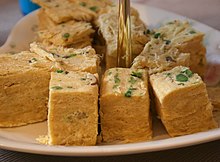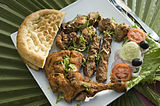Soan papdi: Difference between revisions
Removing more cites template; sourcing looks adequate Tags: Mobile edit Mobile web edit Advanced mobile edit |
No edit summary Tags: Visual edit Mobile edit Mobile web edit |
||
| (11 intermediate revisions by 8 users not shown) | |||
| Line 1: | Line 1: | ||
{{short description|Indian dessert}} |
{{short description|Indian dessert}} |
||
{{redirect|Soan Papdi|the 2015 Tamil language film by that name|Soan Papdi (film)}} |
{{redirect|Soan Papdi|the 2015 Tamil language film by that name|Soan Papdi (film)}}{{Infobox food |
||
| image = Son papadi.jpg |
|||
}} |
|||
''' |
'''Soan papdi''' ([[Bengali language|Bengali]]: শন পাপডি় ''śan pāpṛi'', [[Hindi]]: सोन/सन पापड़ी ''son/sohan pāpṛī''), also known as '''san papri''', '''shompapri''', '''sohan papdi''', '''shonpapdi'''<ref name="Soan Papdi">{{cite web | url=http://www.food-india.com/recipe/R051_R75/R074.htm | title=Soan Papdi |publisher=Food-india.com | access-date=September 17, 2012}}</ref> is a popular dessert in the [[Indian subcontinent]]. It is made of gram flour (besan), all-purpose flour, ghee, sugar and milk.<ref>{{Cite web |title=Soan Papdi Recipe: How to make Soan Papdi Recipe for Diwali at Home {{!}} Homemade Soan Papdi Recipe |url=https://recipes.timesofindia.com/recipes/soan-papdi/rs55051868.cms |access-date=2023-12-31 |website=recipes.timesofindia.com |language=en}}</ref> It is usually cube-shaped or served as flakes, and has a crisp and flaky texture. Traditionally sold loose in rolled paper cones, modern industrial production has led to it being sold in the form of tightly formed cubes.<ref name="Soan Papdi"/> |
||
== Origin == |
== Origin == |
||
Soan Papdi has no confirmed origin, but it is believed to have originated in the western state of Maharashtra, India.<ref>{{Cite web |date=2022-10-23 |title=Explained: The History Of The Flakiest Indian Dessert, Soan Papdi |url=https://www.indiatimes.com/explainers/trending/explained-how-was-soan-papdi-invented-582782.html |access-date=2023-12-19 |website=IndiaTimes |language=en-IN}}</ref> According to culinary |
Soan Papdi has no confirmed origin, but it is believed to have originated in the western state of Maharashtra, India.<ref>{{Cite web |date=2022-10-23 |title=Explained: The History Of The Flakiest Indian Dessert, Soan Papdi |url=https://www.indiatimes.com/explainers/trending/explained-how-was-soan-papdi-invented-582782.html |access-date=2023-12-19 |website=IndiaTimes |language=en-IN}}</ref> According to culinary anthropologist Kurush F Dalal, Soan papdi is a Persian dish, the word "soan" has a Persian origin and the name comes from the term ''sohan pashmaki''.<ref name=":0">{{Cite web |title=Diwali is incomplete without soan papdi; what makes this humble dish so popular in India? |url=https://indianexpress.com/article/lifestyle/food-wine/diwali-soan-papdi-humble-dish-popular-india-8222785/ |access-date=2023-09-09 |website=Indian Express |language=en-US |quote=Kurush F Dalal, archaeologist and culinary anthropologist, calls it an “incredibly versatile” dish. “Soan papdi is a Persian dish. It comes from [the word] ‘sohan pashmaki’.}}</ref> San Papdi as is it's called in Uttar Pradesh and Bihar, "san" means fibres that the sweet contains. Other speculation ranges from Rajasthan, Uttar Pradesh and Punjab to West Bengal.<ref>{{Cite web |date=2013-10-23 |title=Patisa - Culinary Encyclopedia |url=http://www.ifood.tv/network/patisa |access-date=2023-12-19 |archive-url=https://web.archive.org/web/20131023062240/http://www.ifood.tv/network/patisa |archive-date=2013-10-23 }}</ref><ref>{{Cite web |date=2023-11-25 |title=Homemade Soan Papdi Recipe - Awesome Cuisine |url=https://www.awesomecuisine.com/recipes/312/soan-papdi/ |access-date=2023-12-19 |website=www.awesomecuisine.com |language=en-US}}</ref> It bears some resemblance to the ''[[Dragon's beard candy]]'' in [[China]], ''[[Kkul-tarae]]'' in [[Korea]],<ref>{{Cite web |title=Cotton Candy |url=https://stonesoup.com/post/cotton-candy/ |access-date=2023-04-12 |website=stonesoup.com}}</ref> and Persian [[Pashmak|''pashmaki'']], which gave rise to the Turkish ''[[pişmaniye]]''.<ref>{{Cite web |last= |first= |date=2022-01-30 |title=20 Indian Desserts You Need to Try - Nomad Paradise |url=https://nomadparadise.com/indian-desserts/ |access-date=2022-04-11 |website=Nomad Paradise |language=en-US |quote=Believed to have been derived from the Turkish Pismaniye, soan papdi is often referred to as Indian candy floss as it has a strand-like texture that makes it so soft and flaky.}}</ref> |
||
==Ingredients== |
==Ingredients== |
||
| Line 29: | Line 30: | ||
{{Pakistani dishes}} |
{{Pakistani dishes}} |
||
| ⚫ | |||
| ⚫ | |||
[[Category:Cookies]] |
|||
[[Category:Chickpea dishes]] |
[[Category:Chickpea dishes]] |
||
| ⚫ | |||
| ⚫ | |||
Latest revision as of 17:20, 3 October 2024
 | |
Soan papdi (Bengali: শন পাপডি় śan pāpṛi, Hindi: सोन/सन पापड़ी son/sohan pāpṛī), also known as san papri, shompapri, sohan papdi, shonpapdi[1] is a popular dessert in the Indian subcontinent. It is made of gram flour (besan), all-purpose flour, ghee, sugar and milk.[2] It is usually cube-shaped or served as flakes, and has a crisp and flaky texture. Traditionally sold loose in rolled paper cones, modern industrial production has led to it being sold in the form of tightly formed cubes.[1]
Origin
[edit]Soan Papdi has no confirmed origin, but it is believed to have originated in the western state of Maharashtra, India.[3] According to culinary anthropologist Kurush F Dalal, Soan papdi is a Persian dish, the word "soan" has a Persian origin and the name comes from the term sohan pashmaki.[4] San Papdi as is it's called in Uttar Pradesh and Bihar, "san" means fibres that the sweet contains. Other speculation ranges from Rajasthan, Uttar Pradesh and Punjab to West Bengal.[5][6] It bears some resemblance to the Dragon's beard candy in China, Kkul-tarae in Korea,[7] and Persian pashmaki, which gave rise to the Turkish pişmaniye.[8]
Ingredients
[edit]Its main ingredients are sugar, gram flour, flour, ghee, almond, milk, and cardamom.[9]
See also
[edit]- Sohan (confectionery)
- Sohan halwa
- Pişmaniye, a similar Turkish dessert
- Pashmak, a similar Iranian dessert
References
[edit]- ^ a b "Soan Papdi". Food-india.com. Retrieved September 17, 2012.
- ^ "Soan Papdi Recipe: How to make Soan Papdi Recipe for Diwali at Home | Homemade Soan Papdi Recipe". recipes.timesofindia.com. Retrieved 2023-12-31.
- ^ "Explained: The History Of The Flakiest Indian Dessert, Soan Papdi". IndiaTimes. 2022-10-23. Retrieved 2023-12-19.
- ^ "Diwali is incomplete without soan papdi; what makes this humble dish so popular in India?". Indian Express. Retrieved 2023-09-09.
Kurush F Dalal, archaeologist and culinary anthropologist, calls it an "incredibly versatile" dish. "Soan papdi is a Persian dish. It comes from [the word] 'sohan pashmaki'.
- ^ "Patisa - Culinary Encyclopedia". 2013-10-23. Archived from the original on 2013-10-23. Retrieved 2023-12-19.
- ^ "Homemade Soan Papdi Recipe - Awesome Cuisine". www.awesomecuisine.com. 2023-11-25. Retrieved 2023-12-19.
- ^ "Cotton Candy". stonesoup.com. Retrieved 2023-04-12.
- ^ "20 Indian Desserts You Need to Try - Nomad Paradise". Nomad Paradise. 2022-01-30. Retrieved 2022-04-11.
Believed to have been derived from the Turkish Pismaniye, soan papdi is often referred to as Indian candy floss as it has a strand-like texture that makes it so soft and flaky.
- ^ "Diwali". Indiaoz.com.au. Retrieved September 17, 2012.
External links
[edit]- Annotated video recipe illustrates traditional hand-made technique for creating Soan Papdi's crisp multi-layers (filmed at Shreya's Sweets Hampankatta, Mangalore); ·Permaculturetravel· YouTube Channel
- Demonstration of modern mechanized equipment in the making of pişmaniye, a related Turkish confection

